-
水稻是中国三大粮食作物之一,1949年至2009年间,我国水稻的平均播种面积占粮食作物总播种面积的27%,总产量占粮食总产量的42%,单位面积产量为粮食作物平均单产的1.52倍[1].四川省是中国13个粮食主产区之一,水稻是四川省最主要的粮食作物,其产量占粮食总产的42.6%.在全球气候变暖背景下,四川省的气候资源和农业气候资源也发生了相应变化[2-4],热量条件改善固然有利于作物生物量的积累,但与气候变暖相伴发生的气候变率的增大则明显增加了干旱、高温、低温和洪涝等农业气象灾害的发生频率.部分年份发生的持续低温、高温灾害造成该区域水稻出现烂秧或者秧苗质量降低、花而不实或者结实不良的现象,严重影响了该地区和中国粮食的安全生产[5].
有研究指出[6-7],水稻生长季内发生的农业气象灾害,如干旱、高温热害、低温冷害、连阴雨等会对水稻造成严重影响,不同地区、不同时段发生的高温和低温灾害对水稻生长的影响不同[8-10].气候变化背景下高温、低温灾害对水稻产量形成的影响已引起国内外学者的广泛关注[11-14],然而,针对四川省单季稻高温、低温致灾因子危险性分析的研究较少.本文基于四川省地面气象观测数据和农业气象观测站的单季稻生产数据,利用数理统计方法,从灾害发生次数、频率和强度3个方面评估四川省单季稻生育期内高温和低温致灾因子的危险性,拟为四川省水稻的防灾、减灾和稻作制度的调整提供科学依据,为保障国家粮食安全及推动农业经济的可持续发展提供参考.
HTML
-
四川省单季稻主要分布于四川盆地、盆周边山区和川西南山地区,按照地理、地貌类型和种植区的形成现状,主要以单季稻种植为主.本文选取单季稻种植区26个气象台站(图 1)1981年-2012年的逐日平均气温、最低气温和最高气温资料,统计分析1981年-2012年农业气象观测站的观测数据,并结合大田生产调查资料,获得了各种植区域单季稻播种至成熟期的时间(表 1).
-
将日最高(最低)气温连续3天大于(小于)3基点温度的上限(下限)温度定义为水稻高温热害(低温冷害)的指标[15-18].参照文献的研究结果[15, 19-21],结合四川省水稻的实际生长情况,确定四川省水稻在各生育期的3基点温度(表 2).
本文以灾害的持续时间来表示高温和低温的灾害强度,将持续3天以上的高温或低温作为一次灾害过程,以高温、低温过程的平均持续天数作为灾害强度指标.由于四川省单季稻高温、低温灾害主要表现为秧田期的低温冷害以及花期、灌浆结实期的高温热害,因此本文基于水稻不同生育期的3基点温度指标,统计分析四川省单季稻秧田期的低温(STN)、开花期的高温(BFX)、灌浆结实期高温(RTX)的发生次数、发生频率及强度.
-
将水稻某生育期内日最高气温或者最低气温达到其生育期对应的高温、低温标准且持续3天及以上作为一次高温或者低温过程,即1次灾害;灾害发生次数定义为水稻生育期内出现灾害过程的总次数.
灾害发生频率的公式为:
式中:f是发生频率(%);n是统计时段内作物生育期发生某种灾害的总年数;N是统计时段的总年数.
灾害强度的公式为:
式中:D是灾害强度(天/次);dnum是作物某生育期内发生高温或者低温灾害的总天数;cnum是作物某生育期内发生高温或者低温灾害的总次数.
-
利用倾向率[22]来表示变量的趋势变化,建立Xi和ti间的一元线性回归方程:
式中:Xi是变量,ti是Xi对应的时间变化,n是样本量,a与b是回归系数.以b的10倍表示变量的倾向率.
-
采用Microsoft Excel 2007软件对数据进行处理和绘图,采用Surfer11软件对结果进行空间表达.
1.1. 研究区域概况
1.2. 研究方法
1.2.1. 水稻生育期内高低温灾害指标
1.2.2. 水稻高温、低温致灾因子的危险性分析方法
1.2.3. 倾向率
1.2.4. 数据处理
-
研究发现,1981年-2012年研究区域各站点单季稻秧田期低温(STN)的平均发生频率为68.8%,开花期高温(BFX)和灌浆结实期高温(RTX)的平均发生频率分别为15.8%和67.1%(图 2).
进一步分析1981年-2012年四川省单季稻生育期高温、低温灾害发生频率的空间分布发现:秧田期低温发生频率除盆地中部较低外,其余大部区域较高,均超过60%(图 3-a);开花期高温发生频率的空间分布呈由西南向东北增加的趋势,盆地东北部的发生率40%~59%(图 3-b);灌浆结实期高温发生频率呈由西向东增加的趋势,高发区集中在盆地中、南部和东北部(发生频率>60%)(图 3-c).
-
1981年-2012年,研究区各站点单季稻秧田期低温的平均年灾害发生次数为1.10次,年极端灾害发生次数为1.73次;各站点开花期和灌浆结实期高温的平均年灾害发生次数分别为0.20次和1.10次,年极端灾害发生次数分别为1.00次和2.31次(图 4).
进一步分析1981年-2012年四川省单季稻生育期高温、低温灾害发生次数的空间分布发现:近30年来,大部份地区秧田期的低温发生次数在50次以下,仅盆地东北部的部分地区发生次数在50次以上(图 5-a);开花期高温发生次数总体偏少,仅在盆地东北部达到13~17次(图 5-b);大部份地区灌浆结实期的高温发生次数为26~65次(图 5-c).
-
1981年-2012年,研究区域各个站点单季稻秧田期低温平均灾害强度为5.83天/次,极值为9.93天/次;开花期的高温平均灾害强度为2.99天/次,极值为7.94天/次;灌浆结实期的高温平均灾害强度为6.52天/次,极值为14.03天/次(图 6).
进一步分析1981年-2012年四川省单季稻各生育阶段高温、低温灾害发生强度的空间分布发现:大部份地区秧田期的低温强度为4~12天/次,仅川东北个别地区的低温强度17~26天/次(图 7-a);开花期高温发生强度普遍较低,仅在盆地中、南部和川东北部分地区达6~7天/次(图 7-b);灌浆结实期高温发生强度也呈现西低东高的分布特征,高值区集中在盆地中、南部和东北部,强度为8~9天/次(图 7-c).
-
表 3是1981年-2012年四川省单季稻灾害发生次数和强度的变化趋势.由表可知,1981年-2012年,四川省单季稻秧田期低温发生次数呈显著减少趋势,变幅为每10年-0.21次;低温发生强度呈不显著的降低趋势,变幅为每10年-0.15天/次.开花期高温发生次数呈不显著的增加趋势,变幅为每10年0.03次;而高温发生强度呈不显著的降低趋势,变幅为每10年-0.59天/次.灌浆结实期高温发生次数和强度呈不显著的增加趋势,变幅分别为每10年0.10次和0.40天/次.
2.1. 单季稻高温和低温灾害发生频率比较
2.2. 单季稻高温和低温灾害发生次数比较
2.3. 单季稻高温和低温灾害发生强度比较
2.4. 单季稻高温和低温灾害变化特征比较
-
1981年-2012年,四川省各个站点单季稻秧田期低温、开花期高温和灌浆结实期高温的平均发生频率分别为68.8%、15.8%和67.1%.近30年来,秧田期低温发生频率除盆地中部较低外,其余大部均超过60%;开花期和灌浆结实期高温发生频率的空间分布总体呈西低东高的趋势.
1981年-2012年,各个站点单季稻秧田期低温的平均年发生次数为1.10次,年极端发生次数为1.73次;各个站点开花期和灌浆结实期高温的平均年发生次数分别为0.20次和1.10次,年极端发生次数分别为1.00次和2.31次.近30年来,大部份地区秧田期的低温发生次数在50次以下;开花期高温发生次数总体偏少,仅在盆地东北部达到13~17次;大部份地区灌浆结实期的高温发生次数为26~65次.
1981年-2012年,各个站点单季稻秧田期低温平均灾害强度为5.83天/次,极值为9.93天/次;开花期和灌浆结实期的高温平均灾害强度分别为2.99天/次和6.52天/次,极值分别为7.94天/次和14.03天/次.近30年来,大部地份区秧田期的低温强度为4~12天/次;开花期高温发生强度普遍较低;灌浆结实期高温发生强度也呈东高西低的分布特征,高值区集中在盆地中、东部,强度为8~9天/次.
1981年-2012年,单季稻秧田期低温发生次数呈显著减少趋势,而发生强度呈不显著的降低趋势;开花期高温发生次数呈不显著的增加趋势,而发生强度呈不显著的降低趋势;灌浆结实期高温发生次数和强度均呈不显著的增加趋势.
在全球气候变化背景下,四川省单季稻秧田期低温致灾因子危险性风险降低,但仍要关注该阶段水分不足对水稻出苗的影响.同时,四川省单季稻生育后期高温灾害发生次数的增加将不利于单季稻的正常灌浆,甚至导致严重减产,未来可以选择中、晚熟品种以规避高温热害的危害;其次,培育和采用抗热的水稻品种也是应对热害变化的重要措施之一.另外,虽然四川省稻区现有不少水利工程,但标准低、病害多、老化严重,渠系配套差且破坏严重,灾害之年难以满足需水要求,应加快大中型水利工程修建的步伐,尽可能多地蓄积降水,增加水稻的保灌面积,同时发展节水灌溉,以应对后期灾害的影响.
水稻高温和低温灾害的发生是一个复杂的过程,它和地形条件、天气气候背景、种植制度以及品种等诸多因素相关,本文仅利用温度指标和生育期数据评估气候变化背景下四川省单季稻高低温致灾因子的危险性风险,未来还需要结合孕灾环境敏感性、承灾体脆弱性和防灾减灾能力等进行四川省单季稻高低温灾害的风险评估,为水稻的实际生产服务.

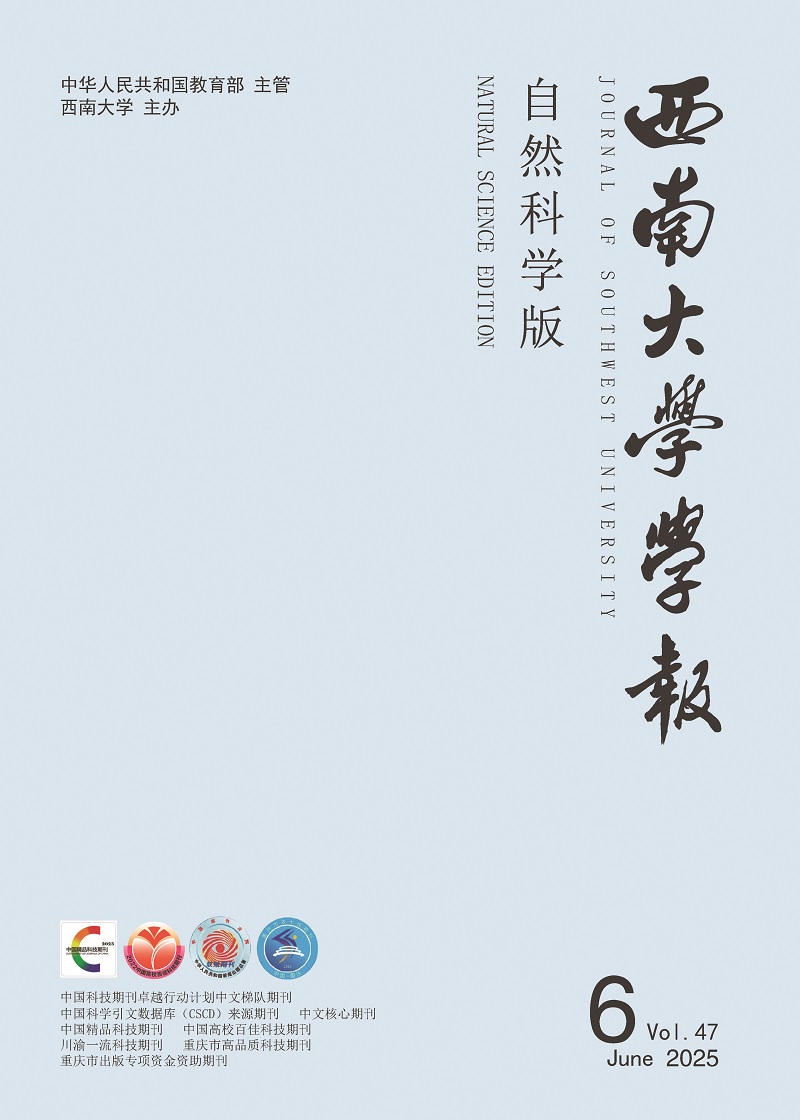


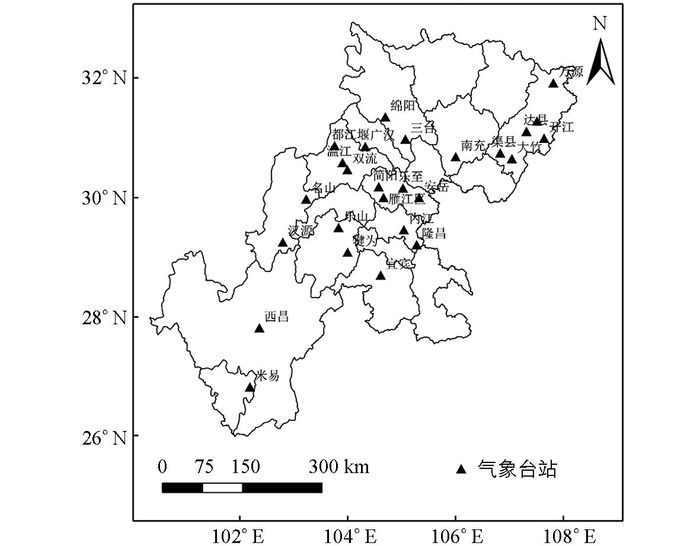


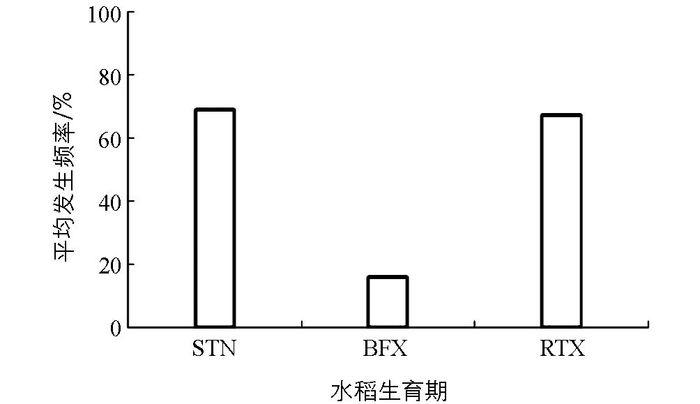

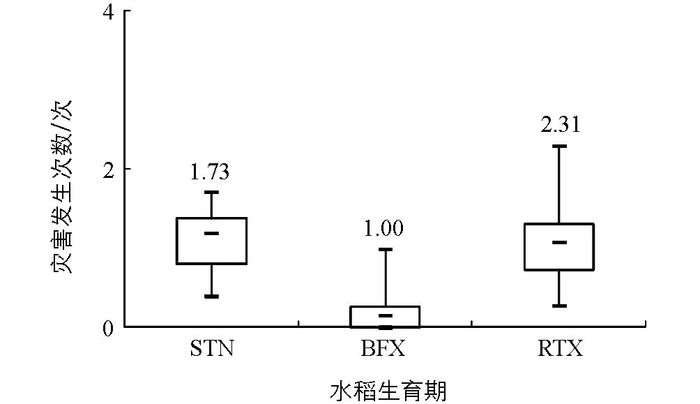
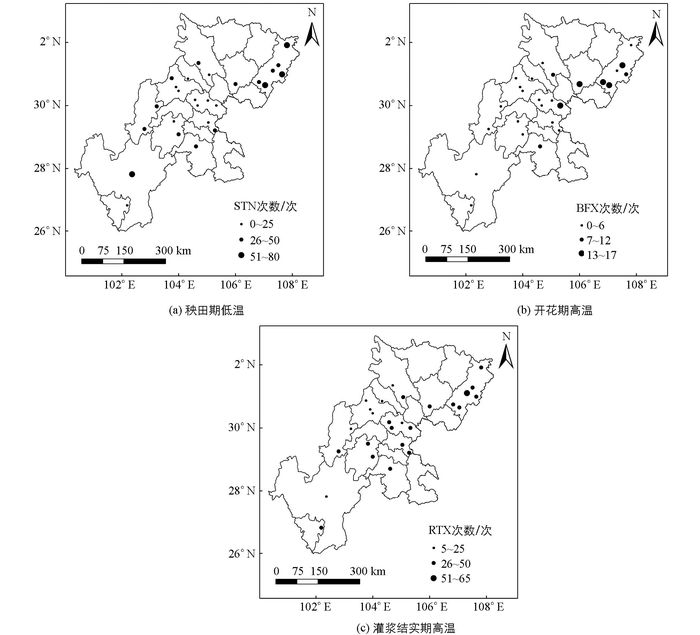
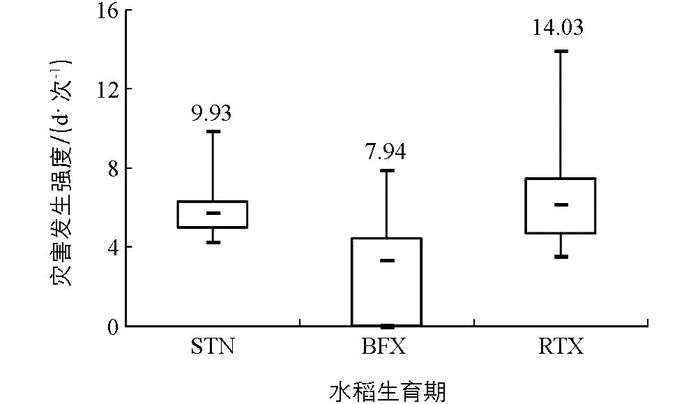
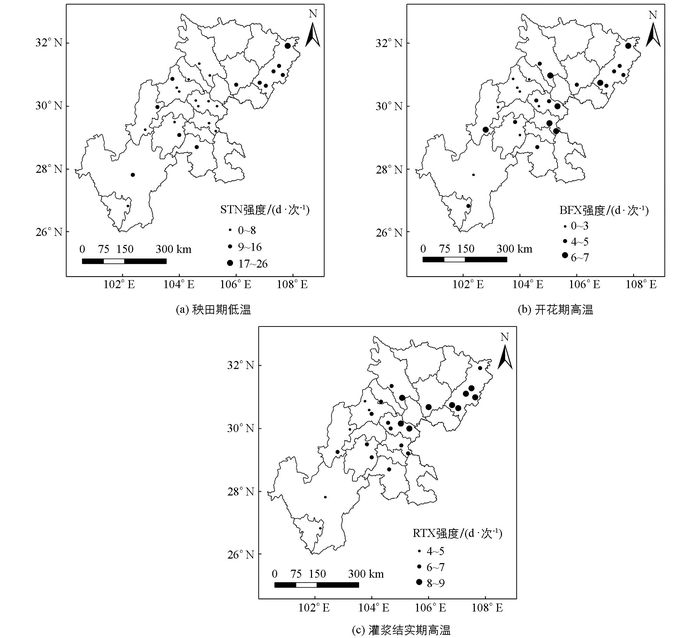
 DownLoad:
DownLoad: